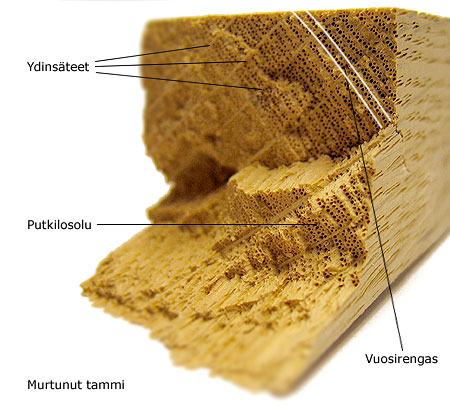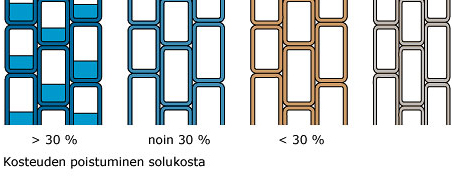STRENGTH OF WOOD
Factors affecting strength characteristics
Summer wood – spring wood
The amount of summer wood in a tree significantly affects the durability of the wood, as it is stronger than spring wood. Thicker cell walls and smaller cell cavities contribute to the better durability of summer wood, making it denser than spring wood.
Density
Wood density refers to the mass of a piece measuring 1 m³. Since the moisture of the wood affects the mass, the density of wood is generally defined when at 15% humidity.
Wood material is often uneven due to the different structures of spring and summer wood. The cell walls of spring wood are thin and brittle, while summer wood cells are stronger.

The density of wood affects its strength characteristics. The bulk density of the cell wall is generally about 1500 kg/m³. However, the density of coniferous trees is slightly higher than that of deciduous trees.
Shrinking and expansion of wood
Wood is an anisotropic substance, meaning that it swells and shrinks in various directions and in different ways. There is little longitudinal shrinking and expansion of wood due to moisture, but the transverse shrinking and expansion may be pronounced. It must be taken into account when designing structures and details.
Spring wood is more porous than summer wood, so it shrinks more when drying. When dried strongly, the wood splits in the transverse direction.

Moisture
The moisture of wood significantly affects its strength below the saturation point. In general, the strength properties of wood improve as the moisture content decreases. The improvement in strength properties is based on the movement of the cell walls closer to one another and their attachment to one another. Wood moisture affects the compression strength and bending strength, but the effect on the tensile strength in the grain direction is small.
When wood is dried, the free water in the cell cavity evaporates first. When all the free water has left the wood, the moisture bound to the wood cells begins to evaporate. The moisture state of wood, where the free water has been removed but the cell walls contain the maximum amount of water, is called the saturation point (30%) of the wood grains. As the moisture in the wood decreases, the wood cells begin to evaporate and the wood begins to shrink.

As pine heartwood and the whole wood material in the spruce dry, they are aspirated. This means that the pores of the wood cells close completely when they dry. Thus, for example, the wood cannot be impregnated because the cells cannot receive and accept the impregnating agent.
Temperature
The mechanical properties of wood are deteriorated as the wood is warmed. If the wood is exposed to high heat for an extended period of time, its strength properties are reduced.
Time
The aging of wood does not impair its durability. However, with age, micro-organisms living in the wood as well as constant stress diminish its durability properties. Continuous fluctuations in circumstances and stress reduce the durability of wood more than when the circumstances and stress are even.